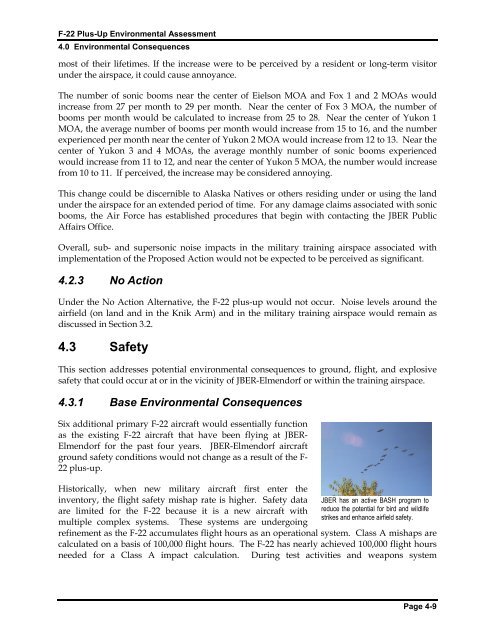F-22 Plus-Up Environmental Assessment - Joint Base Elmendorf ...
F-22 Plus-Up Environmental Assessment - Joint Base Elmendorf ...
F-22 Plus-Up Environmental Assessment - Joint Base Elmendorf ...
Create successful ePaper yourself
Turn your PDF publications into a flip-book with our unique Google optimized e-Paper software.
F-<strong>22</strong> <strong>Plus</strong>-<strong>Up</strong> <strong>Environmental</strong> <strong>Assessment</strong><br />
4.0 <strong>Environmental</strong> Consequences<br />
most of their lifetimes. If the increase were to be perceived by a resident or long-term visitor<br />
under the airspace, it could cause annoyance.<br />
The number of sonic booms near the center of Eielson MOA and Fox 1 and 2 MOAs would<br />
increase from 27 per month to 29 per month. Near the center of Fox 3 MOA, the number of<br />
booms per month would be calculated to increase from 25 to 28. Near the center of Yukon 1<br />
MOA, the average number of booms per month would increase from 15 to 16, and the number<br />
experienced per month near the center of Yukon 2 MOA would increase from 12 to 13. Near the<br />
center of Yukon 3 and 4 MOAs, the average monthly number of sonic booms experienced<br />
would increase from 11 to 12, and near the center of Yukon 5 MOA, the number would increase<br />
from 10 to 11. If perceived, the increase may be considered annoying.<br />
This change could be discernible to Alaska Natives or others residing under or using the land<br />
under the airspace for an extended period of time. For any damage claims associated with sonic<br />
booms, the Air Force has established procedures that begin with contacting the JBER Public<br />
Affairs Office.<br />
Overall, sub- and supersonic noise impacts in the military training airspace associated with<br />
implementation of the Proposed Action would not be expected to be perceived as significant.<br />
4.2.3 No Action<br />
Under the No Action Alternative, the F-<strong>22</strong> plus-up would not occur. Noise levels around the<br />
airfield (on land and in the Knik Arm) and in the military training airspace would remain as<br />
discussed in Section 3.2.<br />
4.3 Safety<br />
This section addresses potential environmental consequences to ground, flight, and explosive<br />
safety that could occur at or in the vicinity of JBER-<strong>Elmendorf</strong> or within the training airspace.<br />
4.3.1 <strong>Base</strong> <strong>Environmental</strong> Consequences<br />
Six additional primary F-<strong>22</strong> aircraft would essentially function<br />
as the existing F-<strong>22</strong> aircraft that have been flying at JBER-<br />
<strong>Elmendorf</strong> for the past four years. JBER-<strong>Elmendorf</strong> aircraft<br />
ground safety conditions would not change as a result of the F-<br />
<strong>22</strong> plus-up.<br />
Historically, when new military aircraft first enter the<br />
inventory, the flight safety mishap rate is higher. Safety data<br />
are limited for the F-<strong>22</strong> because it is a new aircraft with<br />
multiple complex systems. These systems are undergoing<br />
JBER has an active BASH program to<br />
reduce the potential for bird and wildlife<br />
strikes and enhance airfield safety.<br />
refinement as the F-<strong>22</strong> accumulates flight hours as an operational system. Class A mishaps are<br />
calculated on a basis of 100,000 flight hours. The F-<strong>22</strong> has nearly achieved 100,000 flight hours<br />
needed for a Class A impact calculation. During test activities and weapons system<br />
Page 4-9
















